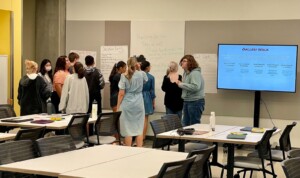New Frame for ESEA: Half Right, Big Risk
Message refined, Secretary Duncan is doing the morning show circuit socializing a proposal for the reauthorization of federal education policy. He’s attempting to assemble the first bipartisan coalition of the Obama administration to address a major piece of legislation. It won’t be easy and it probably won’t happen this year but he’s landed on a rhetorical frame that could work.
On NPR this morning, Duncan gave No Child Left Behind credit for shining a spotlight on the achievement gap by requiring that states use individual student data rather than relying on averages to judge school quality. But he quickly criticized the bill for being squishy on goals and tight on means and suggested that we should “Flip NCLB on its head.”
NCLB focused on reading and math in grades 3 to 8 and allowed states to use their own standards and set their own goals. Duncan is pushing college and career ready graduation as the goal—a great idea but tricky to measure. This is the most important statistic for cities and states but we haven’t been able to measure it (grad rates are complicated and so is defining college ready).
Here’s an example of why this shift is important: most of the roughly 70% of American kids that graduate from high school attempt college. A placement exam at a local community college typically determines if they are ‘college ready’ not the better-known SAT or ACT exams. This hidden gateway throws half of the students into remedial courses where they pay to learn what they should have learned in high school. It’s ridiculous and tragic. Duncan is right, we need a common ‘college ready’ goal that tells students when they’re ready to earn college credit and allows us to measure education systems on the most important outcome.
On to the next big idea: rewarding excellence. Duncan wants to “learn from it, replicate it, reward it.” All sounds very bipartisan. This framed incentive philosophy is reflected in the Race to the Top competition and is an important change strategy that I supported in a previous post. It’s in keeping with the ‘tight on goals, loose on means’ approach. However, efforts to build a bipartisan bill around ‘loose on means’ approach could walk away from two key civil rights advances embodied in NCLB: the good teacher promise and the good school promise.
We have NCLB because states and cities were not addressing chronic school failure. The most important component of NCLB, what almost everyone now hates, is a school accountability framework based on Adequate Yearly Progress. There were lots of problems that never got fixed, but it was an attempt to promise every American family access to a good school. NCLB also attempted to promise every student access to a good teacher (but in the absence of data, used some bad proxies for quality).
The New York Times, which has been spot on for a year, summarizes the view of education equality advocates:
But it will be no less important to protect what is good in the law and resist pressure from powerful forces — teachers’ unions, state governments and other groups — that may seek to weaken it. In particular, the administration and Congress need to preserve and strengthen provisions that hold states accountable for placing a qualified teacher in every classroom and closing the achievement gap between poor children and their wealthy contemporaries.
Finally, it’s worth noting a subtle difference in public responsibility vs. public delivery. Duncan is a pragmatic public school guy: make the system work for kids, do more of what works. His support for charter schools is more about adding good seats to the system than expanding parent choice. When the public system failed, NCLB attempted to insert choice and tutoring services. It reflected a multi-provider philosophy that, in small ways, encouraged private investment and entrepreneurship. It now appears that Education will remain the only branch of the federal government to hold at bay private investment and involvement.
We’re entering the most dynamic period in history where anyone can learn anything anytime anywhere. While our education conversation drifts back toward the ‘one-best system’ philosophy, new tools and new schools are springing up in emerging economies where rapidly evolving education sectors are hotbeds of innovation supported by public and private investment. We’re rehashing a 2002 fight while the rest of the world is thinking about 2020.
The least we owe American kids is the promise of a good teacher and a good school. The next version of federal policy must improve on that pledge. But we can do so much more to launch a learning revolution. It doesn’t sound like we’ll have that conversation.




0 Comments
Leave a Comment
Your email address will not be published. All fields are required.